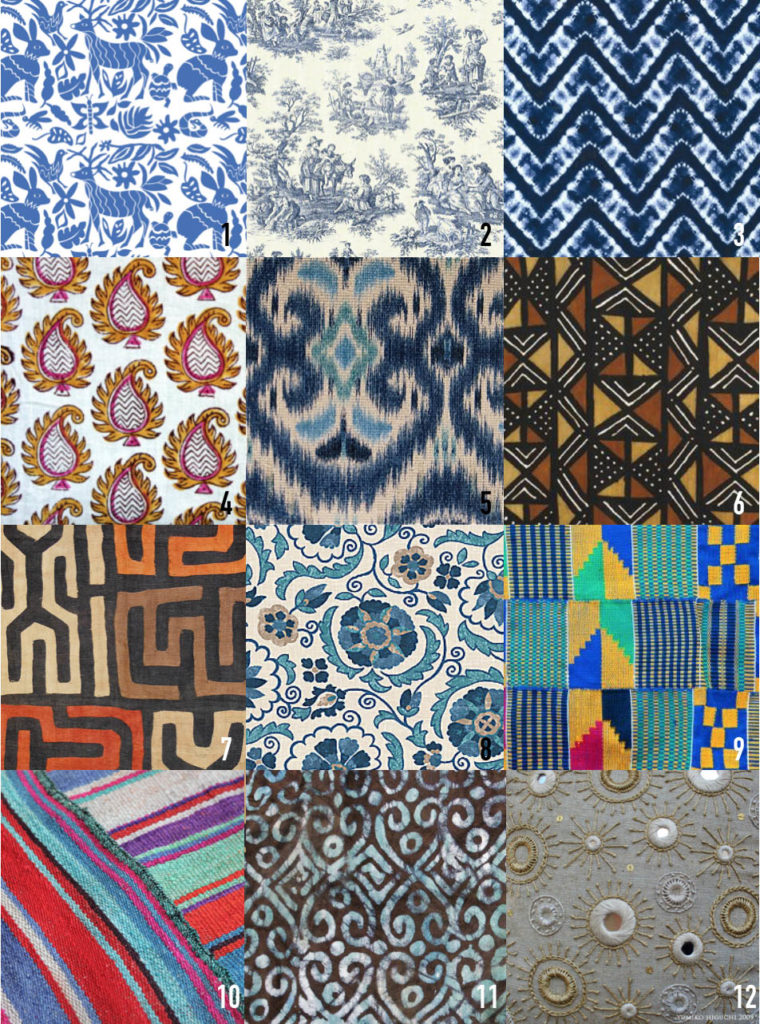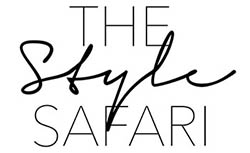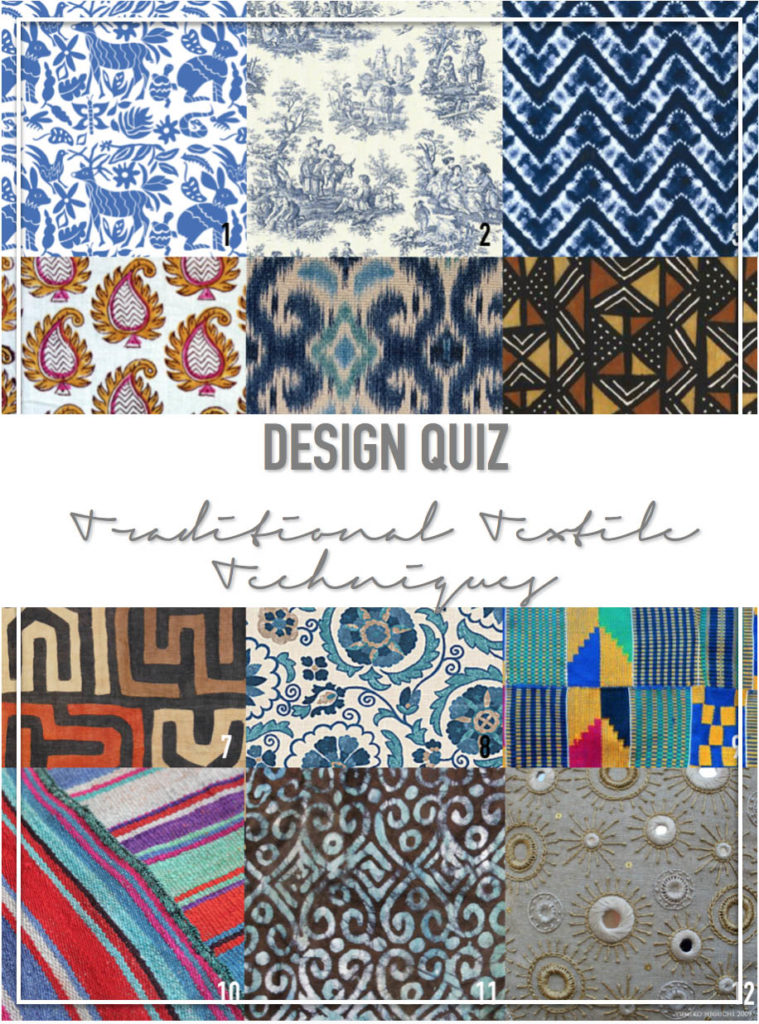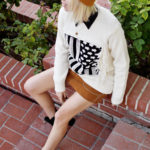Can YOU Identify 12 of Traditional Textile Techniques from around the World?
Let’s see!
What’s your ethnic textile IQ? Take my short matching quiz to see if you can identify which of the following techniques is shown in the 2 textile samples below. You will not only become a much more informed shopper (for Home Decor and Fashion Items) but you will definitely know what to look for when searching for authentic textiles. Scroll down for the answers (no peeking!) and for notes on the origins of each textile and how to identify it.
Game on!
Textile Samples

Traditional Textile Techniques Names (In no particular order)
A. Batik
B. Mudcloth
C. Otomi
D. Shisha
E. Toile de Jouy
F. Block Print
G. Suzani
H. Kente cloth
I. Shibori
J. Frazada
K. Ikat
L. Kuba cloth
How do you think you did? Were you able to nail all 12 images? Were there any that tripped you up? Here we go with the answers…
>>>>>>>>>>>>>>>>>>>>>>>>>> <<<<<<<<<<<<<<<<<<<<<<<<<<
1.C
Otomi is a traditional embroidered cloth from the Central Mexican Valley. The animals and florals depicted in these embroideries are said to be taken from ancient Aztec cave drawings, as they are shown in their most simplistic form. Nevertheless, a real Otomi embroidery is a beautiful piece to withhold; while I showed just a solid color example, the multi color versions are breathtaking (and not cheap!)
2. E
Originating from Ireland, Toile de Jouy quickly became popular in England and France in the 18th century. Toile de Jouy typically depicts everyday, pastoral scenes with men or women going about their duties. They are repeat prints that were historical seen in home decor only, but more recently became popular in fashion with designers like Carolina Herrera and Carven.
3. I
By now, you guys should be able to recognize Shibori when you see it, but I figured I would throw in a little bit of loop for you in case it was too easy. Shibori is the world’s first tie-dye, but is a lot more sophisticated then that techno-color crap you made in summer camp. Although the dress I made was used with wood blocks and clamps, the truest form of Shibori is made by actually tying, or sewing stitches into the fabric and gathering them together to make circles, lines or zig zags. Look close at any tied Shibori fabric and you will see teeny tiny holes where the thread went through!
4. F
Block printing is one of the oldest and simplest forms of surface textile design and the origin is unclear. Wood blocks are done in the traditional method, where the designer etches out a design on the block, paints it with a roller, and then prints the design (most often in a repeat manner) onto fabric. The process can be quite intricate with each color being a separate block. Many block prints these days digitally repeated, but either digital or not, the signature of a block prints is the slight overlapping of color where blocks might not have been perfectly matched up… i.e. human error. I created a block print in college and am thinking I might need to retry this technique at home, thoughts?
5. K
Ikat is one of the most complicated traditional textile techniques and thus also one of the most digitally reproduced out there. Traditionally, the individual yarns are tied off and dyed (sometimes multiple colors) so that when weaving a pattern forms. Since the dying of the threads individually is difficult to make exact, when the final textile is woven it creates a type of ‘bleed’ effect. Ikat has origins in Asia and South America, where the designs were quite complicated, but these days mostly geometric Ikat patterns are seen in the market.
6. B
When I see this textile, I immediately think “Oh that Mudcloth is so hot right now” because it is one of the trendiest fabrics in home decor at the moment. Although there are lots of dupes, (I even have my own for sale!) traditional mudcloth is made using layers and layers of mud as a resist that originates from Mali. The cloth is then soaked in a leafy dye bath, which results in a yellow colored fabric. The mud part remains brown, where the yellow part can then be bleached or kept as yellow for more varied designs. This was a bit of a trick because most mud cloths we see in the market are bi-color, but many of the authentic versions are shades of brown and yellow.
7. L
Did you get this one? It was another little trick. On a computer screen, Kuba cloth looks similar to mudcloth (strictly in loose geometric design and colors), but this Congolese textile gets it pattern from a completely different technique. The design is actually made of cutting out shapes in a raffia-type fabric and hand stitched onto a base cloth. The result is bold, textural, and quite beautiful for pillows, blankets and larger scale items. Often the color palette is similar to mudcloth, but sometimes these works of art can be colorful as well
8. G
Real Suzanis are hard to characterize on the computer, as they are typically fully embroidered, usually on a base cloth of cotton, with silk or cotton embroidery. Originating from Uzbekistan and other Central Asian countries, Suzanis are most identifiable by their circular floral motifs, but also often feature sun and moons, and leaves and vines. They are most commonly seen in home decor and while real ones are boring, the overuse of knockoffs leaves me yawning…
9. H
Kente cloth is one of the most interesting textiles, because it is actually made up of cut strips of fabric that are woven into a solid base cloth. This strip cloth weaving method gets its name from the Ghanian word Kenten, which means basket… makes sense, no? It was traditionally worn only in special occasions or by kings, as each color has a meaning. I just learned about this cloth recently, so read more about it’s history and the meaning of the colors here.
10. J
Heavy Bolivian Frazadas were woven to protect the wearer from the extreme cold in the high Andes Mountains. The beautiful stripe patterns woven into the thick Alpacan wool are made with natural dyes, and symbolize local identities and lineages of tribes. They are woven in two separate pieces and attached with a decorate center seam, and are used for blankets, throws, picnics, rugs and tablecloths. I’m dying to get my hands on one of these!
11. A
Originating from Bali, Batik is another traditional textile technique that has been adopted worldwide. The surface design is created by painting wax on the cloth to create a resist. The wax area remains undyed, and the remaining area absorbs the dye color. The process can then be repeated over and over for multiple colors, working from lightest to darkest (although the most common Batiks are in one color, Indigo). It is easy to identify real Batiks by the crackling in the lines, caused by dye seeping into the cracking wax. It’s also a fun project to try at home!
12. D
Indian Shisha is one of the identifiable of all my textile picks, yet few people know the name. Traditional Shisha fabric is hand embroidered with small circular motifs, around cut glass inserts or mirrors. Historically the Shisha embroideries would contain coins or blown glass pieces, but nowadays mass produced mini mirrors are used for the intricate detailing. Shish are commonly used in saris and other clothing, as well as tapestries, tablecloths and other home textiles.
Love this Quiz? Take my Traditional Blue and White Pottery Quiz to see how good your knowledge is on one of the most classic of all design techniques!



